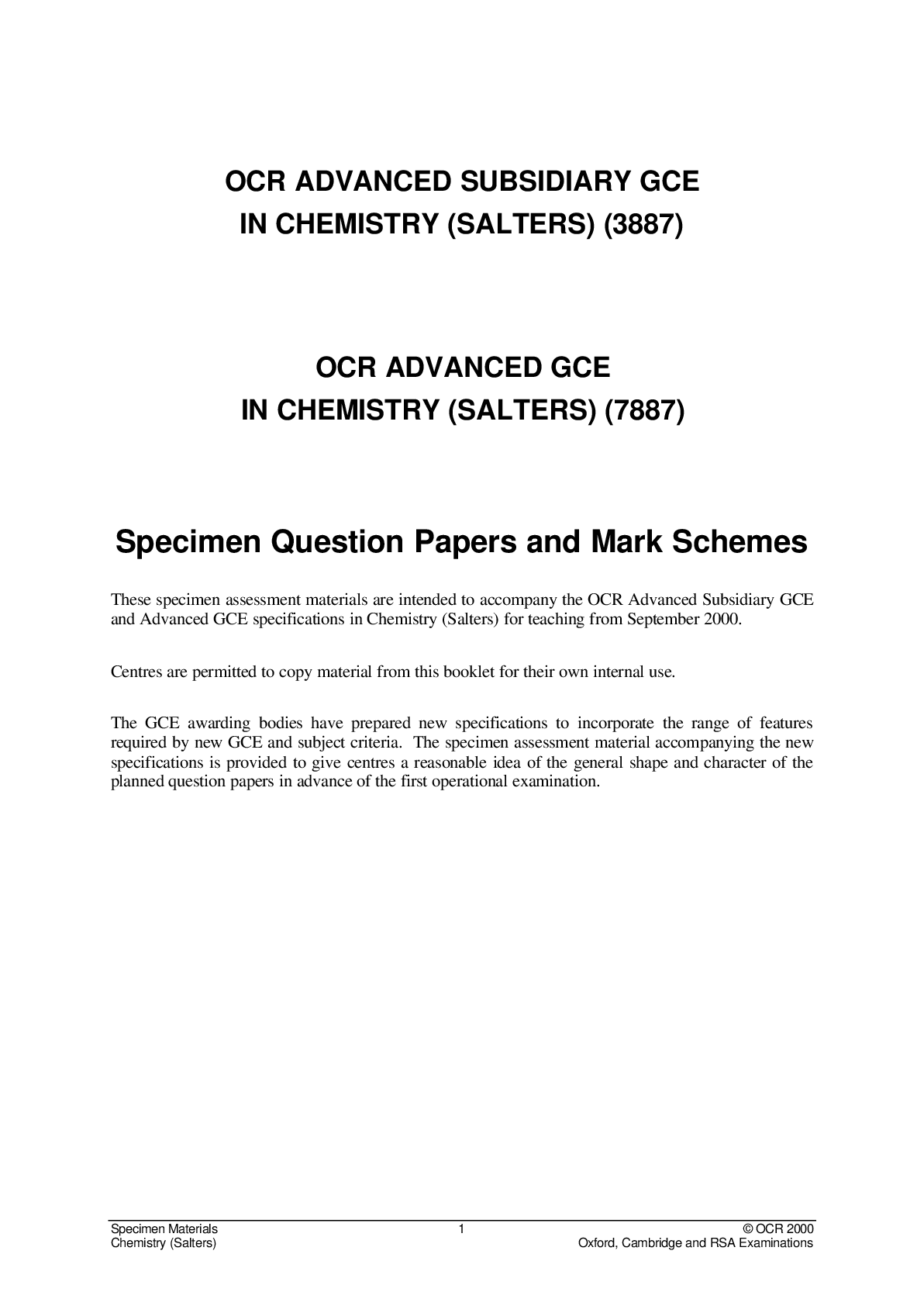Oxford Cambridge and RSA Examinations
Advanced Subsidiary GCE
CHEMISTRY (SALTERS)
CHEMISTRY FOR LIFE 2850
Specimen Paper
Candidates answer on the question paper.
Additional materials:
Data Booklet for Chemistry (Salters)
To be brought by candidate: electronic calculator
TIME 1 hour 30 minutes
INSTRUCTIONS TO CANDIDATES
Write your name, Centre number and candidate number in the spaces at the top of this
page.
Answer all questions.
Write your answers in the spaces provided on the question paper.
There should be ample space for your answers. If you need more space for answers or
rough work you may use the blank spaces at the end of questions or any blank pages.
Rough work that is not to be marked should be crossed out.
You will be awarded marks for the quality of your written communication where an
answer requires a piece of extended writing.
INFORMATION FOR CANDIDATES
The number of marks is given in brackets [ ] at the end of each question or part question.
A copy of the Periodic Table and other tables of information are provided in a data
booklet for use with this examination; other necessary data are given as required in the
questions.
You may use an electronic calculator.
.
Specimen Materials 4 © OCR 2000
Chemistry (Salters) Oxford, Cambridge and RSA Examinations
Answer all questions.
1. Bone consists of a complex mixture of calcium salts, such as calcium carbonate, and
other material. If bone is strongly heated, the calcium salts turn into calcium oxide,
CaO. This can be separated from the other material by dissolving it in dilute
hydrochloric acid, to form calcium chloride, CaCl2, solution.
(a) (i) Draw a flow diagram to show how calcium carbonate in bone is turned
into calcium chloride. Show the formulae of the compounds connected by
labelled arrows.
[3]
(ii) Complete and balance the chemical equation for the reaction between solid
calcium oxide and dilute hydrochloric acid, showing state symbols.
CaO + HCl
[2]
(b) An experiment showed that 14.4 g of calcium oxide were made from a sample
of bone of mass 50.0 g. (Ar
: Ca, 40; O, 16)
Calculate:
(i) the amount in moles of CaO in 14.4 g;
[2]
Specimen Materials 5 © OCR 2000
Chemistry (Salters) Oxford, Cambridge and RSA Examinations
(ii) the amount in moles of Ca in the bone sample;
[1]
(iii) the % of calcium by mass in the bone.
[2]
(c) Strontium compounds are incorporated into bones because their chemistry is
similar to that of calcium compounds. For example, both strontium and calcium
form ions with the same charge. Explain, in terms of the Periodic Table, the
electronic structures of the atoms and ionisation energies, why calcium and
strontium (and their compounds) have similar chemical properties.
( Note: In this question, 1 mark is available for the quality of written communication).
....................................................................................................................................................
....................................................................................................................................................
....................................................................................................................................................
....................................................................................................................................................
....................................................................................................................................................
....................................................................................................................................................
..................................................................................……………………………………… [6]
Specimen Materials 6 © OCR 2000
Chemistry (Salters) Oxford, Cambridge and RSA Examinations
(d) Strontium-90, 90
38 Sr, is a radioactive isotope of strontium that emits –
particles
(electrons). It was produced in nuclear fall-out and became incorporated in
peoples’ bones.
(i) For the strontium-90 nucleus, write down the number of
protons ........................................................................................................... [1]
neutrons ......................................................................................................... [1]
(ii) Write a nuclear equation for the process by which a strontium-90 nucleus
emits a
– particle, representing the – particle as 10
e.
[3]
(iii) A sample of naturally-occurring strontium was placed in a mass
spectrometer and the following peaks were obtained:
Mass Intensity (%)
84 0.56
86 9.86
87 7.02
88 82.56
Calculate the relative atomic mass of the sample of strontium, giving your
answer to three significant figures. Show your working
Read More


